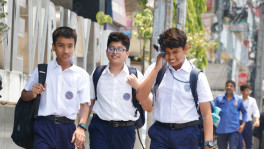Can your child or grandchild really give you Covid-19?
'Children seem less likely to transmit than adults, but they certainly can transmit.'

As schools across England plan to reopen this week for nearly nine million students, the families are wondering, what is the danger to us? If they're out there and pick up the virus, will they carry it home to their parents then? Perhaps, the elderly grandparents or others?
Researchers writing in the British Medical Journal earlier this week concluded that no healthy children in the UK had died from Covid-19, reports The Daily Mail.
According to Public Health England, six out of 650 children infected with the virus died. These six children had health problems that were 'profound' and 'life-limiting.' Less than a quarter required intensive care, most of whom already had pre-existing illness. Only one percent of the 130,000 cases between January and May, were children aged 15 and under.
This is evidence that children have a 'small role' in the spread of the disease, according to health experts. But it would be disingenuous to suggest that reopening schools will be entirely risk-free.
"Everyone always wants to know if it's safe for the kids, understandably," says Leeds University virologist Stephen Griffin. "But what we should also be asking is, 'Is it safe for our population?' I absolutely believe we should be prioritising the kids' return to school. But we haven't eliminated transmission of the virus within communities, which means there will be a trade-off," he adds.
Jeffrey Shaman, expert in infectious disease at Columbia University in New York, told The Daily Mail, "The question is, what happens when children get it? Are they effectively dead ends? Or are they capable of communicating the virus and spreading it to other people? And I think the evidence is not conclusive."
Small studies suggest children hospitalised with Covid-19 carry as much of the virus as adults – and may be as infectious. But as University of Bath infection expert Dr Andrew Preston points out, "Those displaying symptoms would be isolating, not walking around in schools."
The real-world evidence shows the virus can, and does, spread among school populations – as seen last week in Dundee, where 21 staff members and two children in one school tested positive. But experts say this, and many other examples from around the world, doesn't suggest children are 'super-spreaders', as they are known to be with viruses such as flu. In the main, evidence shows the virus is brought into schools from the community, mainly by staff.
Despite this, because most schools have been closed, or open to a very limited number of students, all experts agree there is lack of evidence about what will happen next.
Dr Alasdair Munro, an expert in paediatric infectious disease at University Hospital Southampton NHS Foundation Trust, who has been reviewing the evidence on the transmission of Covid-19 by children, acknowledges, "The risk [of reopening] is primarily of increasing community transmission by teachers spreading infection to each other, parents, grandparents etc, who will, in turn, spread it on.
'Children seem less likely to transmit than adults, but they certainly can transmit.'
It is known from other studies that households – by their very nature, a confined space that a number of people share – are the most common place to become infected.
Yang Yang, a biostatistician at the University of Florida's College of Public Health, is currently involved in a study based on 20,000 households. He says his early results do show children infect adults living in the same home.
Even catching a common cold can cause serious problems for 48-year-old Tim Wotton. The communications director from London lives with genetic condition cystic fibrosis (CF), which means he's at high risk of lung infections.
He's already well used to taking precautions to avoid seasonal viruses and flu – careful hand-washing and avoiding crowds – as it could cause his health to deteriorate rapidly.
Yet the father of one admits the pandemic has posed a new kind of challenge. When CF patients were advised to shield in March, Tim – who lives with senior nurse wife, Katie, and 13-year-old son, Felix – moved to Southampton to shield with his retired nurse mother. He lived there for more than four months.
Tim moved back when it became apparent that Felix was increasingly anxious about his father living away.
"We'd meet outdoors sometimes but we couldn't hug – we even tried passing a rugby ball between each other to create some sense of intimacy, but eventually we decided the risk he posed to me was smaller than the distress being caused to him."
With a new school year round the corner, and Felix going back full time, Tim has decided to remain at home but there will be certain protocols in place to minimise his risk of infection.
The family have always taken precautions around sharing cutlery, for example. "Katie's job makes her alert to the importance of hygiene, and though she doesn't work on a Covid ward, she changes clothes before coming home after each shift," Tim explains. "When Felix returns to school he'll change clothes when he comes home as well as wash his hands and face.
"I'm still undecided about whether I'll keep a bit of physical distance from Felix at the beginning of term."
Age appears to be a significant factor – with teens possibly posing a greater risk than younger kids.
One big South Korean study found children under ten were half as infectious as those aged ten to 19. And at a French school in a badly affected area, just one child under 15 tested positive for the virus, compared with 40 per cent of teachers and older pupils.
It has also been reported that a secondary school in Israel traced a large outbreak involving 153 pupils and 25 teachers back to two infected students. Its health ministry says the rising number of infections among students is the 'primary factor' in the country's recent spike in cases. But the incident does seem to be unusual.
It is not clear why teens pose a greater risk, as they're no more likely to become unwell with Covid-19.
However, Dr Griffin points out they also develop more ACE2 receptors – the immune cells that the new coronavirus binds to, causing infection, like a key in a lock – around this time as part of normal development. This all suggests that it is secondary schools, not primary schools, which may be the biggest risk for transmission.
Dr Munro said, "These are small numbers, but there are early lessons from them."
The biggest sign yet that the Government agrees that there is at least the potential for teenagers to transmit the virus comes from its controversial U-turn this week to introduce face masks in secondary schools.
From next week, pupils in Year Seven (ages 11 and 12) and above will have to wear masks in crowded common areas, such as corridors, where social distancing is difficult, but not in classrooms.
Masks will only be compulsory in classrooms in areas which are in local lockdown – elsewhere, it'll be up to the headmaster.
And on Friday night, Public Health England issued new guidance advising secondary schools in areas with significant rises in cases to adopt a rota system that limits the number of children at school.
The edict on masks is based on advice from the World Health Organisation, which also recommends children aged 12 and over (like adults) should wear masks in any situation where they cannot stay one metre away from others, such as on trains and in shops.
But there is no specific scientific evidence that masks can prevent the virus spreading in schools.
Experts do, however, point to the fact that masks can prevent the spread of flu among children.
Dr David Strain, clinical senior lecturer at the University of Exeter, said, "In the absence of clarity, given the known detrimental impact of school closures, we must err on the side of caution in order to ensure that when schools re-open they remain open."
Despite these measures, Paul Hunter, Professor of Medicine at the University of East Anglia, warns, "Once schools return, and if the general incidence in the UK increases, we are likely to see many more school-based outbreaks, with considerable disruption this autumn."
Dr Griffin argues that all these theories will be stress-tested from next week onward.
"Over lockdown, when only essential key worker children were back, staff numbers were reduced and they were taking appropriate precautions," he says. "Next week you'll have teachers, staff, and parents coming to the gate. The spread might not be as rampant as flu, but I'd be surprised if it didn't just run through the school population as we've seen in Scotland."
So what can be done to protect the most vulnerable?
Astonishingly, despite insisting that children rarely transmit the virus, the joint Chief Medical Officer's statement this week put the responsibility for stopping school and community outbreaks... on children.
They said youngsters 'should be engaged in the process of establishing Covid-19-secure measures – to help protect their wider families, teachers and other school staff.' There was little more specific forthcoming.
For Dr Griffin and his family, there is anxiety. He feels a trade- off has been made, which feels 'upsetting'. 'We'll wash the kids when they come home and wash their clothes.'
There's limited evidence that mask-wearing in households where someone is infected could reduce the risk of further spread.
Otherwise, the best measures are those which everyone has been taking since the start of the pandemic, Dr Griffin suggests, isolating infected cases, cleaning surfaces regularly, washing hands and ventilating the house.
If you have any symptoms, don't hug that vulnerable relative. But, of course, the million dollar question is, what if no one has any symptoms – is hugging the grandkids allowed then?
When asked what to do by a family with two ten-year-olds who had been 'shielding to keep Granny safe', Dr Munro said it was 'very difficult' and a 'cost benefit decision like all things in life'.
"Children certainly do not present zero risk – just likely a lower risk than another adult might," he wrote. "These types of decisions should be based on individual risk in context of local rates of community transmission, not easy."
He added, 'Constant shouting from unions about 'when it's safe' have not helped.
"It's never 'safe'. We must decide when the relative unsafety of doing something is worse than the relative unsafety of not doing it."
And of course, no amount of government guidance will ever be able to tell you that.


 Keep updated, follow The Business Standard's Google news channel
Keep updated, follow The Business Standard's Google news channel
















